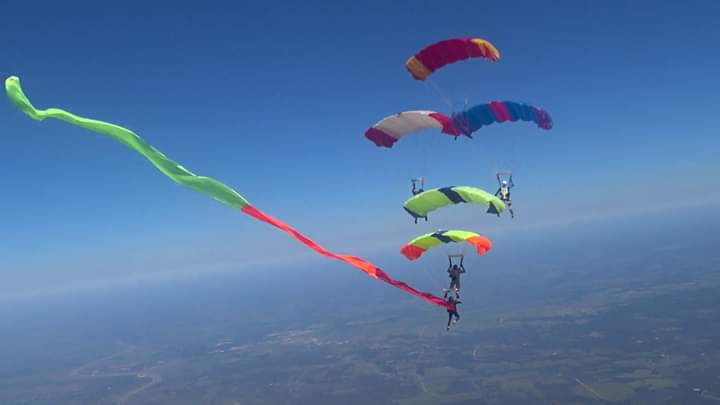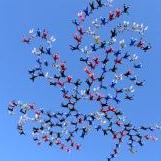Recommended Posts
It dumbfounded me (and still kinda does) that someone with so many years and jumps would spend the time and energy he has teaching me so much, and he's become a great friend in the process. He's not an instructor, but I think he should be because he has a wonderful gift.
Sorry to digress from the thread topic. I'll get back on it - What is the difference between a stall turn and a flat turn?
All things work together for good to them that love God...Romans 8:28
obelixtim 100
Don't be shy!!!.
Most times you just have to have the courage to approach people.......usually its pretty obvious who the good guys and gals are.....
Of course skydiving has its fair share of arrogant arses and egotrippers who look at students and low timers like they are a piece of dogshit......Personally I just love taking the piss out of them.....and I've done it to a few......I can't stand those types.......not real skydivers in my mind....
Anyway, to answer your question......
Flat turn: The canopy remains parallel to the ground throughout the turn....(I'm talking about a student canopy now, but the principle is generally the same whatever canopy you have)...usually by pulling both toggles down together to about half brakes, then letting one toggle up slightly while simultaneously pulling a little more on the opposite toggle......the turn should be gentle and feel quite smooth....and loss of altitude is minimal....
Stall turn: The canopy drops out of the sky.....Haul both brakes right down together till the canopy stalls....(it rocks back behind you a little and feels like its gonna pull you over backwards, feels quite weird the first time you try it.). Then let one toggle all the way up quickly...the canopy will turn you quite violently (by comparison to a flat turn) and drop out of the sky.....not to be used close to the ground.....often used in CRW when a jumper needs to get down quick, but stay close to the formation...as in rotations.....
These manoevres should be practised by ALL jumpers up high until you develop an awareness of the flight characteristics of your canopy......but be sure to make sure you have clear airspace around and below you, and it definitly helps to let any others who may be going out the door with you know your intentions.....
Giving your canopy a good workout will teach you a lot about how a parachute flies, and give you confidence in it and yourself.....
I would suggest you can play with the canopy like that for a couple of thousand feet, but probably at 1000 feet its time to switch on to landing mode.....its not a good idea to do radical manoevres down lower than that, because 1: you should be sussing out a safe landing area (not necessarily the DZ either if you can't make it for some reason), and 2: radical input is not smart if you are in the zone where your AAD might come into play.....(I've seen an AAD fire in this scenario), and two canopies out at this point makes things interesting to say the least.....
But up high, don't be afraid to give that canopy a damn good thrashing!!!. I encourage my jumpers to give it heaps up high....they love it......its all good stuff.....
billvon 2,400
>turn....(I'm talking about a student canopy now, but the principle is
> generally the same whatever canopy you have)...usually by pulling
> both toggles down together to about half brakes, then letting one
>toggle up slightly while simultaneously pulling a little more on the
>opposite toggle......
That's not a flat turn, that's a braked turn. A braked turn is the manuever you describe, and is defined in the SIM as part of the ISP. A flat turn is a turn where you lose the least altitude for the greatest turn possible, and come out of the turn at normal flying speed so you can flare immediately if you need to. They are useful in different scenarios. If you are over a safe landing area and need to turn as much as possible before landing (say, to avoid an obstacle) a flat turn is the way to go. If you are turning at the last minute to aim for the center of a tree, a braked turn is the way to go, because it will slow you down more before impact.
kkeenan 13
Low Turn = Emergency Room or Worse
______________________________________________
Dude, you are so awesome...
Can I be on your ash jump ?
AFFI 0
Quote>Flat turn: The canopy remains parallel to the ground throughout the
>turn....(I'm talking about a student canopy now, but the principle is
> generally the same whatever canopy you have)...usually by pulling
> both toggles down together to about half brakes, then letting one
>toggle up slightly while simultaneously pulling a little more on the
>opposite toggle......
That's not a flat turn, that's a braked turn. A braked turn is the manuever you describe, and is defined in the SIM as part of the ISP. A flat turn is a turn where you lose the least altitude for the greatest turn possible, and come out of the turn at normal flying speed so you can flare immediately if you need to. They are useful in different scenarios. If you are over a safe landing area and need to turn as much as possible before landing (say, to avoid an obstacle) a flat turn is the way to go. If you are turning at the last minute to aim for the center of a tree, a braked turn is the way to go, because it will slow you down more before impact.
Can you please describe the steps used in the "flat turn"? What do you do with your toggles, are you altering the canopy's angle of attack or is the turn executed from full flight?
All things work together for good to them that love God...Romans 8:28
MB38 0
I understand that the safe altitude for making a 180 will vary from canopy to canopy and wingloading to wingloading. I also understand that the altitude lost in a turn is very dependant on the type of turn - flat, braked, slow carving, toggle whip, etc.
Should it be based on what one determines to be "comfortable" based on what they know about their canopy? Clearly not, too many people have felt "comfortable" with their altitude to make a turn and killed themselves.
Should it be a number? I don't personally believe so: that number would change on every jump with the wind conditions and with every jumper per their canopy and loading.
Case in point: about a week ago, I made my first jump on a Safire 2 189 @ about 1.1. I was rather far out, but my eye told me I'd make it back in time to turn to land. I risered to point it at the DZ and did a few practice flares on the way back.
I flew to the end of the landing area and realized I was a little lower than I wished I was. My guess based on what my [untrained] eyes told me and what my altimeter said a few seconds earlier was that I was around 200-250 feet. Not too low to do a controlled 180.
Unfortunately, I had literally never turned the canopy with toggles before. I did what my brain expected to be a flat turn [as learned from other canopies] and only turned about 90 degrees. Long story short, I finished the turn in brakes and stood the landing up fine. As compared to other landings that day, I came in notably faster... I think I had some extra speed from the turn or from letting up on the brakes - not sure which [or I could have had no extra speed at all... I don't have many jumps on this canopy or at all... I'm certainly terrible at judging these things].
I spoke with an instructor who witnessed the landing and he said there was nothing to worry about. If anything, I ended up lower than planned because I entered the turn so cautiously. I spent so much time in brakes that I lost more altitude than I would've if I'd just turned onto final normally.
That said, the next jump I did was a hop & pop from 12,500. I got a better feel for things and how to do flat turns and braked turns under that canopy *specifically*, rather than guessing at 250'.
So my altitude apparently wasn't too low in that situation. If I was doing the jump again, I would've left it in brakes longer after deployment so I would've had more altitude to play with by the time I got back. I would've - of course - released the brakes at a safe enough altitude such that if there were any complications I could deal with them in time.
Cliff's Notes: I felt like I was high enough to turn. During the turn I felt nervous. I landed fine. Instructor says that I did a good [enough] job.
Back to the original question, now that my post has become obscenely long: how low is too low? How can one know when they are too low before they start to turn... rather than finding out as they dig a hole?
AFFI 0
QuoteI've been taught to steer my canopy all the way to the ground. Sometimes I've had to turn on final to avoid hitting something/someone, and even one time I had to make corrections to not land in a ravine. Is what I'm doing flat turns?
Well, according to Bill, Flat Turns are not Braked Turns - So I do not understand the semantics involved between the two or the differences.
I will send you a piece of our student manual that describes in easy to understand terms this type of life saving turns and on stall advoidence cuz when executing a braked turn low to the ground you dont want to stall the canopy so it is best to know where your stall point is br practicing up high. It would be a very lenghty post to teach it all online.
Common out for Skyfest and we can go over some things if you would like.
obelixtim 100
rie
qm
Out of curiosity [and this may be a discussion for another thread or it may be simple], when is a "low turn" a "low turn"? I.E. when should one look at the ground, think about their altitude and say "nah, I'll take this downwind".
If you have time to be thinking that you are probably OK........
But when you think ""FFFFUUUUCCCCKKKK" then you've probably blown it....
Difficult question to answer with precision because there are too many variables......body weight, canopy size, weather conditions, (wind, temperature,) turbulence, landing altitude, amongst them.....probably a few others I hsaven't thought of just now.....
The altitude you turn at might be fine one day, the next day might be too low....the best advice to stay injury free might be to err on the side of caution, make your decisions early, and have an escape plan that enables you to bail out of the situation safely.......
Pushing the envelope all the time pretty much guarantees that an accident is certain....sooner or later....



.thumb.jpg.4bb795e2eaf21b8b300039a5e1ec7f92.jpg)

What we teach is no more than 90, look first and identify the clear area and focus on the safe area. students who watch the obstacles are more likely to get target fixation.
but this is diverting from the thread.
Tim
Share this post
Link to post
Share on other sites